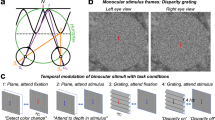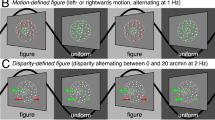Abstract
OUR two eyes see slightly different images of the world, and this enables us to estimate the position of objects in depth. When we look at a fixed point in space we can correctly judge the distance of an object that is in front of, or behind this point by the amount of disparity of its retinal images. Our brain combines these disparate images in such a way that we can see the object as single within a certain limit of disparity. This limit is called Panum's fusional area; for fine-line targets the disparity limits are found to be ±7 min arc for central (foveal) vision, and larger for peripheral vision (for review see ref. 1). However, Fender and Julesz2 demonstrated that fusion may be extended beyond Panum's area when random-dot stereograms are used. Experiments reported here demonstrate that Panum's area also increases for stimuli with blurred contours, that is, for contours containing lower spatial frequencies.
This is a preview of subscription content, access via your institution
Access options
Subscribe to this journal
Receive 51 print issues and online access
$199.00 per year
only $3.90 per issue
Buy this article
- Purchase on Springer Link
- Instant access to full article PDF
Prices may be subject to local taxes which are calculated during checkout
Similar content being viewed by others
References
Bishop, P. O. in Adler's Physiology of the Eye, Ch. 21 (C. V. Mosby, St Louis, 1975).
Fender, D. & Julesz, B. J. opt. Soc. Am. 57, 819–830 (1967).
Blakemore, C. & Hague, B. J. Physiol., Lond. 225, 437–455 (1972).
Tolhurst, D. J. Vision Res. 12, 797–804 (1972).
Shapley, R. M. & Tolhurst, D. J. J. Physiol., Lond. 229, 169–183 (1973).
Kulikowski, J. & King-Smith, P. E. Vision Res. 13, 1455–1478 (1973).
King-Smith, P. E. & Kulikowski, J. J. Physiol., Lond. 236, 5P–6P (1973).
Campbell, F. W. & Robson, J. G. J. Physiol., Lond. 197, 551–566 (1968).
Robinson, J. O. The Psychology of Visual Illusion. (Hutchinson, London, 1972).
Barlow, H. B., Blakemore, C. & Pettigrew, J. D. J. Physiol., Lond. 193, 327–34 (1967).
Nikara, T., Bishop, P. O. & Pettigrew, J. D. Expl Brain Res. 6, 343–372 (1968).
Joshua, D. E. & Bishop, P. E. Expl. Brain Res. 10, 389–416 (1970).
Graham, N., Robson, J. G. & Nachmias, J. Vision Res. 18, 815–825 (1978).
Maffei, L. & Fiorentini, A. Vision Res. 17, 257–264 (1977).
Author information
Authors and Affiliations
Rights and permissions
About this article
Cite this article
KULIKOWSKI, J. Limit of single vision in stereopsis depends on contour sharpness. Nature 275, 126–127 (1978). https://doi.org/10.1038/275126a0
Received:
Accepted:
Published:
Issue Date:
DOI: https://doi.org/10.1038/275126a0
This article is cited by
-
Ecologically valid defocus blur contributes to avoidance of interocular suppression in half-occluded zones
Optical Review (2014)
-
How is binocularity maintained during convergence and divergence?
Eye (1996)
-
Effect of luminance and contrast on stereoscopic acuity
Graefe's Archive for Clinical and Experimental Ophthalmology (1990)
Comments
By submitting a comment you agree to abide by our Terms and Community Guidelines. If you find something abusive or that does not comply with our terms or guidelines please flag it as inappropriate.



